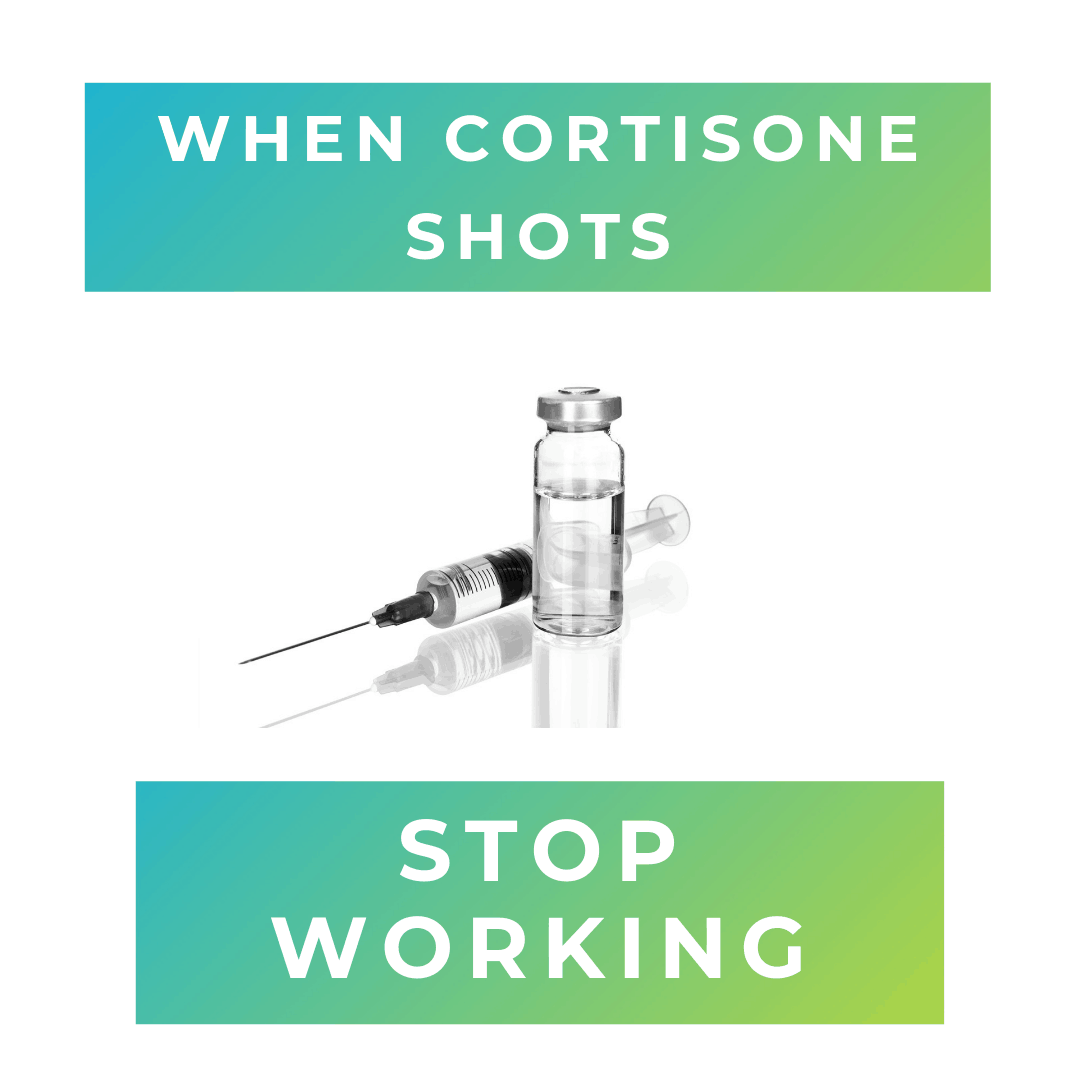
11 Jul When Cortisone Shots Stop Working
Imagine having shoulder pain for 6 months that your friends recommend cortisone shots for … and the pain is continuously getting worse.
Or even 8 years of shoulder pain that stops you from doing what you love.
Like it did for our patient Cheryl (She talks about “cortisone shots” at 0:18).
Nothing seems to take the pain away, and you are desperate for relief.
Your co-workers give rave reviews for a local Ortho. At your appointment, you are given a cortisone shot in your shoulder, and it works!
FINALLY, you have no pain and can resume your workouts and activities of daily life. But three months later, you can’t move your shoulder, and the pain is worse than it’s ever been.
What now?
What happens when cortisone shots stop working?
Cortisone shots are one of the most commonly prescribed treatments for muscle and joint pain.
Unfortunately, like many medical interventions they only offer temporary relief, need to be repeated and often lose effectiveness after each shot.
Really where is the harm?
It’s not as if cortisone is an opioid, and “it takes away my pain for a little while.”
Has any physician told you that cortisone shots can lead to some not so desirable side effects like cartilage and joint damage, which are permanent, or even tendon rupture, which may require surgical repair?
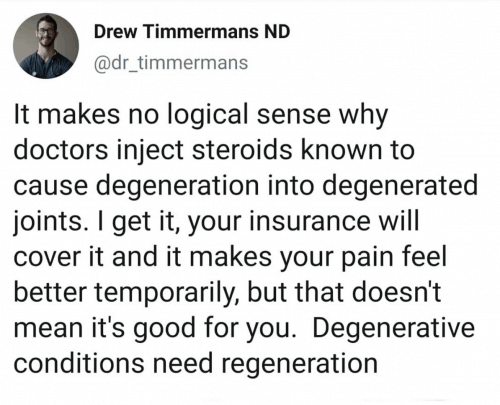
Dr. Timmermans recently posted on his instagram account @regenerativeperformance:
I’m at a point where I believe it’s borderline malpractice for doctors to inject corticosteroids into knees with osteoarthritis. The research is so insanely clear, and has been for long enough, that steroid injections cause cartilage degeneration. Why the hell are doctors injecting this into knees that are already degenerative?
The approach that should be taken is a regenerative, total joint approach. This includes nutrition, lifestyle, and injections like prolotherapy, prp, or stem cell therapy.
These are some serious side effects of a treatment that only offers temporary relief.
Nobody likes to talk about the medicine when it goes wrong, but we will, so that you have the tools to make an informed decision.
How exactly do cortisone shots work?
Cortisone is a steroid. Steroids reduce inflammation in the body.
Inflammation is like the garbagemen. They come to clean up the garbage from the party you just threw. Only this party brought some walls down inside your house.
Inflammation leads to pain. Physicians prescribe cortisone to “cool down” the inflammation (and send the garbage away without cleaning up the mess), but this doesn’t treat the reason the specific tissue is inflamed.
So what is inflammation?
Inflammation happens when your home couldn’t handle the party. In physical terms, you have:
- Sustained or repetitive muscle contractions for a length of time (i.e. typing for 4 hours straight).
The prolonged time with decreased blood flow causes the body to release free radicals which leads to a process that causes inflammation.
Cortisone shots get rid of the inflammation.
They just don’t get rid of the cause of why the inflammation came in the first place (your house isn’t strong enough).
The “What If ” Scenario was Me
As a US Master level swimmer, I loaded my shoulder joint excessively for many years. Over the years, I would experience aching, stiffness and even burning in my shoulder.
This experience is why I became NJ’s First and Only Soft Tissue “Arm” Specialist.
But I didn’t stop swimming, I would always “push through”.
The pain got to the point that the inflammatory episodes were a 10/10 and I was unable to move my shoulder.
I got scared.
When you are experiencing the worst pain you have ever felt in your life, and you can’t move an entire limb of your body, you will do just about anything to make it stop.
I had several cortisone shots, which would “cool down” the inflammation and let me go back to swimming, but a few months later I would be in the same pain, feeling the same desperation.
Recently I underwent an MRI of my shoulder. I tore my rotator cuff and damaged the shoulder labrum. I have had to stop swimming, a sport and activity I love.
What would have happened if I had received an adequate diagnosis the first time my shoulder became severely inflamed?
Was there anything missing from my diagnosis that could’ve prevented the shoulder damage that is no longer permanently fixable?
A Little Problem Called Adhesion
Inflammation (and constant garbage laying around your house) leads to a little problem called adhesion.
Adhesion is formed of “healthy fascia” gone mad.
Here’s a picture of “healthy fascia” in the forearm.
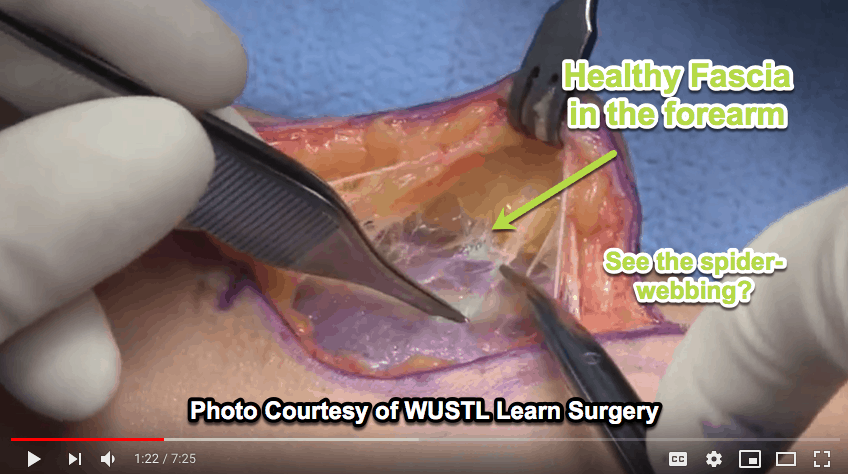
Here’s what it looks like when it thickens, preventing motion. In this case, this patient needs surgery for the “carpal tunnel nerve” also known as the median nerve.
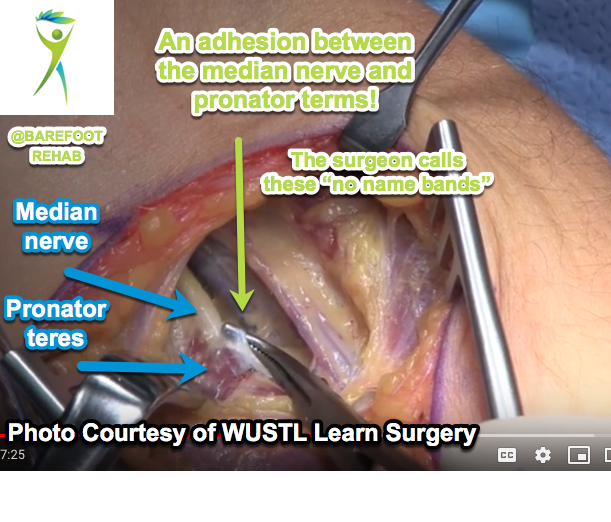
Adhesion, which is kinda like glue in your muscles, is the most common pathology in the muscles, the most under diagnosed, and the good news, the most easily fixed!
Like Justin. He had his adhesion fixed … AFTER trying cortisone shots, pain-killers, and anti-inflammatories.
Adhesion forms due to overuse, trauma, or other conditions which cause inflammation to occur.
Adhesion is the cause. Inflammation is the effect.
How do you get rid of the cause?
Getting Rid of Adhesion Without Surgery
There are two ways to get rid of adhesion:
- surgically scraping it off
- physically breaking it off with Manual Adhesion Release or Instrument Adhesion Release.
Sure, you could’ve gotten surgery for the adhesion between your median nerve and pronator teres.
Or, you could’ve gotten it release without getting cut open.
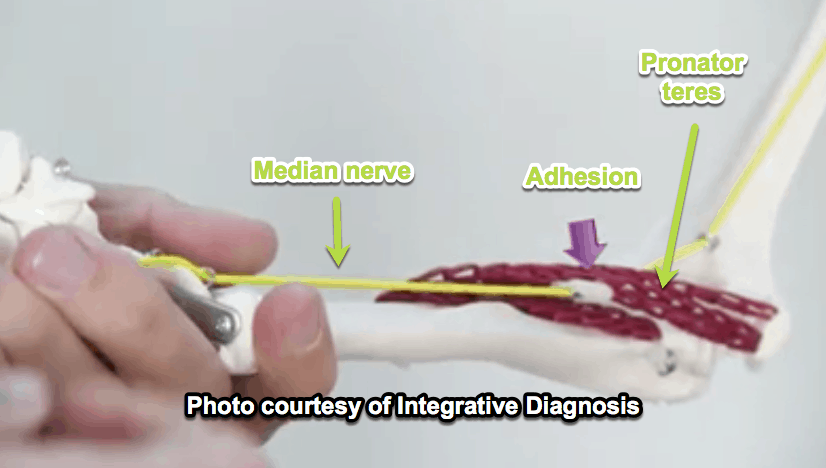
People intuitively understand what trauma is. Trauma is anything that damages tissues like a car accident, spraining your ankle, fractures, or even cuts. Trauma creates adhesion thanks to inflammation.
Microtrauma due to overuse occurs when you use a joint or body part repetitively to perform a certain task, like I did when swimming, leading to a lack of blood flow.
Wait!?
Can’t cortisone shots treat adhesion if they treat inflammation?
No, cortisone simply “cools down” the inflammation for a period of time, without fixing the underlying cause – the adhesion. Once inflammation forms adhesion the only way to remove it is by physically breaking it.
What really happens when someone undergoes repetitive cortisone shots?
According to the research, and especially concerning younger athletic patients, repetitive cortisone shots will lead to weakening of the cartilage and tendons which support the joint, eventually leading to tendon rupture, and speedening up of the natural degenerative process.
Lets recap!
Adhesion (glue in your muscles) is the:
- most common,
- most under-diagnosed,
- and luckily the most fixable of chronic pain conditions.
Everyone has it, and most don’t know it. When inflammation occurs, it is in response to tissue damage, causing adhesion to form as it glues the damaged tissues together.
Unfortunately healthy normal tissue often becomes collateral damage, getting stuck together as well. This is the guy who wasn’t drinking at the party but gets a beer can thrown at his head.
This adhesion causes pain, weakness, and stiffness.
Cortisone shots are among the most common treatments prescribed for these muscle complaints. Cortisone shots are known to decrease inflammation and temporarily relieve pain, but to promote the gluing up of more adhesion by simply covering up damage instead of addressing it.
Before you know it you are stuck in a nasty cycle of inflammation – adhesion- pain – cortisone shot- keep doing the provoking activities – inflammation – adhesion – pain – cortisone shot ….
And it goes on and on.
The damage that cortisone shots have been reported to do to the joints themselves is permanent, and can lead to the need for surgical intervention.
Let us help you get off the cortisone shot merry-go-round by getting your adhesion removed conservatively.
Here’s how we helped a professional dancer with one calf that was tighter than the other.
If you’ve had pain more than 6 months and you’ve tried at least 3 other doctors or therapists (including cortisone shots) without permanent relief, give us a call at Barefoot Rehab in Denville, NJ to see if you’re a candidate for the PERMANENT pain relief we offer our patients.
862-205-4847
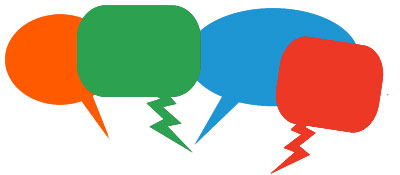 If you’ve had a cortisone shot, how long did the relief last until the pain came back?
If you’ve had a cortisone shot, how long did the relief last until the pain came back?
Research References:
Shah A, et. al. Musculoskeletal Corticosteroid Administration: Current Concepts. Can Assoc Radiol J 2019 Feb, 70(1):29-36
Wang W, et. al. Effectiveness of corticosteroid injections in adhesive capsulitis of the shoulder: a meta-analysis. Medicine (Baltimore), 2017 Jul;96(28)
Honcharuk E, Monica J. Complications Associated with intra-Articular and Extra-Articular Corticosteroid Injections. JBJS Rev. 2016 Dec 13;4(12)
Freire V, Bureau NJ. Injectable Corticosteroids: Take Precautions and Use Caution. Semin Musculoskelet Radiol 2016 Nov:20(5):401-408
Nichols AW. Complications associated with the use of corticosteroids in the treatment of athletic injuries. Clin J Sport Med, 2005 Sep;15(5):370-5


Paul Martell
Posted at 00:09h, 15 DecemberHip pain
Dr. Chris
Posted at 14:19h, 15 DecemberSorry to hear that Paul.